
Free THE LIFE May & June 2023 Wild Things WH�RE TH� A R� Gluten-Free Living 15 Falafel Bowl 11 Grow Your Own Microgreens 26 +
5 g GRASSFED COLLAGEN PER SERVING SUGAR 0g

SOURCE OF MAGNESIUM POTASSIUM AND SODIUM

ENTER FOR A CHANCE TO
1 in 10 chances to win!

SOURCE OF OVER 100% OF VITAMIN C DAILY RECOMMENDED INTAKE
Scan the QR code for contest details
HYDRATION MADE BETTER
@organikahealth organika.com
Lemon Berry
Wild Berry
Strawberry Peach
WIN
good

5
Where the Wild Things Are
Knowledge of foraging goes back thousands of years and it’s currently on the rise. It’s a way of connecting with the natural environment with delicious results—as long as its done safely and sustainably.

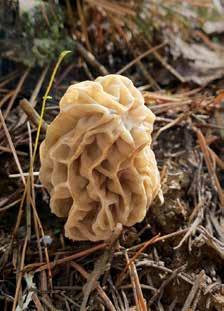

11 29 good TO THE EARTH 23 Bee Cause: Protecting and Enjoying our Precious Pollinators 29 Pick Local Flowers good SELF-CARE 21 Double Dew-ty 26 Grow Your Own Microgreens: Upcycled Packaging Craft Recipe: Mint Chocolate Chip Super Smoothie IN EVERY ISSUE 4 Get the Good Stuff 30 New Good Stuff In-Store good HEALTH 15 Nutritionist Notes: Gluten-Free Living 19 Period Pride good FOOD 8 Field Guide: Cooking with Morel Mushrooms & Fiddleheads Recipe: Morel Mushroom Risotto 11
Bowl
Beet Hummus, Pickled Red Cabbage, Falafel, Cashew Cream, Turmeric Rice, Salad
Falafel
Recipes:
FEATURE
The Good Life the Magazine of Nature’s Fare Markets | 2
Hawthorn Farm Studio
LET’S TALK: HORMONES
Too Hot to Handle
Think you might be perimenopausal? Join us as we get real about what to expect and what Harmony suggests to do to get relief and feel more like yourself.
SPEAKER : Chelan Wilkins
May 2 | Vernon
May 3 | Kelowna
LET’S TALK: ENERGY
May 18 | White Rock
How to Combat Parental Burnout
A guide to better sleep, nutrition and moods so you can parent feeling rested and recharged.
SPEAKERS: Dr. Ally Power, ND & Dr. Rory Gibbons
May 11 | Langley
POP-UP MARKET
Mother’s Day Weekend Blooms
Shop beautiful floral arrangements with local family-owned growers.
Back Country Blooms
May 12 | Vernon
LET’S TALK: HORMONES
Hawthorn Farm Studio
May 13 | Vernon
How to Balance Your Body
Let’s get real with Aeryon Wellness about supporting your hormone changes at every stage so you can look and feel your best
SPEAKERS: Aeryon Ashley & Sarah Collins
May 16 | Vernon
May 17 | Kelowna
LET’S TALK: SKINCARE
May 30 | White Rock
May 31 | Langley
Your Best Routine Yet
Get started creating an effective skincare regime with the co-founder of Mad Hippie.
SPEAKER: Dana Stewart
May 23 | Instagram Live
Marketing Director Stephanie Thatcher
Content Manager Chantelle Nuttley
Creative Director Janna Payne
Copy Editor Marilyn Fransen
SALE
Spring Beauty Night
Pamper yourself with a night out to explore the world of natural beauty and skincare. Guests will enjoy a special event discount, refreshments, samples and prizes.
May 23 | White Rock
May 24 | Langley
SALE
Personal Care Sale
May 25 | Kamloops, Kelowna, West Kelowna
May 26 | Vernon
15% off all personal care (hair, body, skin, cosmetics, oral care) and aromatherapy. Samples, gift baskets and prizes in-store.
May 26 & 27 | All stores
LET’S TALK: SKINCARE
#SkinCycling for Beginners
What to know about the trending less-is-more regime that delivers healthier, happier skin.
SPEAKER: Brianne Rempel
June 1 | Vernon
June 8 | West Kelowna
LET’S TALK: HEALTHY AGING
June 14 | Kelowna
The Sweet & Simple Truth About Blood Sugar
Joleen with Organika helps us learn why managing blood sugar is a key to weight management, mental health and cognitive function.
SPEAKER: Joleen Gruber, B.A., RHN
June 7 | Vernon
June 8 | Kelowna
June 13 | Online
MORE EVENT DETAILS: naturesfare.com/upcoming-events
The health and wellbeing of our customers is central to our mission. We believe that learning how to live your healthiest life should be accessible to everyone. That’s why our Wellness Talks are made available for free to everyone.
Dates subject to change.
THE LIFE
Our calendar MAY & JUNE 2023
© 2023 Nature’s Fare Markets. The materials in this magazine are suggestions only. Nature’s Fare Markets does not guarantee results.
3 | May & June 2023
areEventsback in-store!
GOOD STUFF GET THE



SUPPLEMENT
Cardiovascular support
Can taking care of your heart be as simple as taking black garlic? Whether summer sees you playing tennis, gardening or hiking—and whatever your age—promote cardiovascular health, circulation, reduce inflammation and more with this black garlic formulation triple fermented for superior absorbency plus no aftertaste here!
Living Alchemy Black Garlic Alive

PERSONAL CARE
Self care goals
You know when you find a body care brand that ticks every box, and every product you try is another one you can’t imagine doing without? Sukin is that kind of brand. Founded in 2007, Sukin has long held a stellar reputation for making skincare, hair care and body care products that are natural, affordable and super effective.
Sukin Naturals products





NOTICE
Pack your bags
Compostable plastic and paper shopping bags are being phased out in our stores this summer. When it comes to bagging up at the checkout, BYOB (bring your own bags) is best! Our reusable bags will still be available for purchase.
The Good Life the Magazine of Nature’s Fare Markets | 4
Made
in BC
Where the Wild Things Are
Jeremy Budd fell in love with foraging at age seven, when he first joined his father for a search for pine mushrooms near their Sunshine Coast home. Foraging for seasonal, wild foods was a way of life that continues to this day—the passing of knowledge that has come down through generations on the Italian side of his family.
That knowledge became West Coast Wild Foods when, in his 20s, he met kindred spirit and co-founder Austin Glenn, who had grown up foraging in the Chilcotin. We recently spoke with Jeremy about the pleasures and responsibilities of wild food foraging.

British Columbia’s forests, meadows and mountains offer an incredible bounty of wild foods. And foraging, says Jeremy, is a lost pursuit becoming more popular as people’s desire grows to connect more with the natural environment.
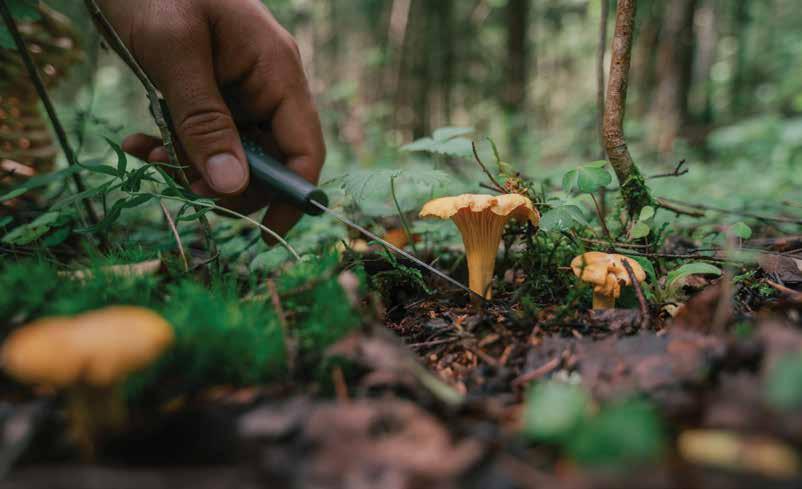
“Knowledge of foraging goes back thousands of years, in every culture in the world. First Nations
people have a lot of existing knowledge, and in European countries, foraging is part of their seasonal, traditional diet. It’s on the rise, again, as more people in younger generations are now interested in harvesting wild foods.
“It’s a way of connecting with the natural environment in a way that’s hard to find today, in anything we do. Usually, when people interact with a forest—hiking or mountain biking—it’s at a faster pace. Foraging is a different speed, incredibly slow and contemplative, and very important for people to really experience the outdoors in an intimate way. You also come to understand how everything is so interconnected and how everything we do has a consequence.”
good FEATURE
Jeremy Budd is a mushroom enthusiast and co-owner of West Coast Wild Foods. He turned his passion of wild mushroom harvesting, love of the outdoors and wild foods into a thriving local business that brings the wonders of wild foods into grocery stores for everyone to enjoy.
“We work with First Nations people who know the land better than anyone. It’s a fantastic process. That’s the future we want.”
5 | May & June 2023
—Jeremy Budd
How to Begin Foraging
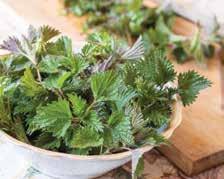
• Do your homework. Visit your library or go online to learn more. The Vancouver Mycological Society is a great resource for mushrooms. www.vanmyco.org

• Find a knowledgeable guide or join a tour. Seasonal walks and tours are available throughout BC.
• Buy a field guide to identify plants.
Be Safe
Pick in verified pesticide-free areas.
• Wear appropriate clothing and footwear, ready for weather changes, rough terrain and dense brush.
• Know how to use a compass to safely return to your campsite or vehicle.

• Tell someone where you are going and the time of your return.
Never underestimate the power of plants. Do not eat or use anything until you are 100% sure it’s safe, especially if your health is challenged or you are pregnant.
Be Respectful
Wild food sustains and protects area wildlife and ecology.
• Leave the land in the same or better condition than when you arrived.
• Protect the site to encourage recovery:
Pick only what you can positively identify and use.
Do not dig up, rake or disturb the forest floor, break branches or remove or disturb moss.
• Be very careful with fires, butts, matches and lighters. Don’t leave your butts behind.
• Obey forest closures.
• Bring your garbage home, and if you see someone else’s garbage, take it out with you.
What to Gather
All the forests around us, of different ages and elevations, offer different wild plants, mushrooms or berries. Look for these finds to be discovered each season, depending on topography, rainfall and temperature.

1. EARLY SPRING
Fiddleheads, young dandelion greens, chickweed, skunk cabbage shoots, purslane, young nettles, wild garlic, blackberry shoots
2. LATE SPRING
Salmonberries, elderberries, morel mushrooms, wild asparagus, wild fennel, plantain, miner’s lettuce, sheep sorrel, elderflower
3. SUMMER
Blackberries, huckleberries, salal berries, Oregon grape berries, wild blueberries
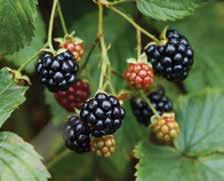
4. FALL
Nuts, rosehips, bearberry (kinnikinnick), and mushrooms including oyster, pine, cauliflower, bear’s tooth, lobster, matsutake, shaggy mane, chanterelle, hedgehog and chicken of the woods
WHERE TO GATHER
Foraging is legal on Crown land and, by invitation and with a permit, on First Nations’ territories. Always ask permission before wandering on reserves or private land. Check your maps to make sure you are not inside a park.
It’s illegal to forage here:
✘ National and Provincial parks
✘ Defense lands
✘ Ecological and special reserves
✘ Recreation areas
1 3 2 4
young nettles blackberries
salmonberries
Continued on next page The Good Life the Magazine of Nature’s Fare Markets | 6
oyster mushrooms
First aid kit
Headlamp
Compass
Charged cell phone with good GPS
Food and water
Bear bell and bear spray
Breathable cloth bags for plants and mushrooms
Sharp knife with sheath
Spoon and brush to remove debris and stems
Gloves
Forage Sustainably
Mushrooms
Treat the environment gently. Deforestation, developments, overharvesting and using tools like rakes damage the delicate environment in which mushrooms grow. If you don’t take great care, mushrooms may not come back. Pick just a few in each patch, then go back in a week to pick a few more. You shouldn’t be able to tell if anything was harvested. Only pick mushrooms at their edible prime. Leave the small ones to grow, spore and reproduce and the old to decompose and enrich the soil for more to grow. If you treat a mushroom patch properly, you can come back year after year to harvest.
Chanterelles

Always cut above the ground. Do not pull them out of the ground. Leave the stem behind and intact. Gently replace any disturbed moss and twigs or debris.
Pine Mushrooms

Pull these out of the ground, then immediately gently brush the grey, mineral-rich soil from the stem and butt of the mushroom with your fingers. Place disturbed soil back in the hole as well as any moss.
Did you know?
Pine needles can be used for making tea, as a natural insect repellent, or as a natural air freshener.

Fiddleheads

More common in northern BC, these young, tightly wound fronds of the ostrich fern taste like a cross between green beans and asparagus. Their tender shoots break easily, so take care not to break, or step on the plants. Always leave multiple fiddleheads in the pod.
Prepare: Lightly steam in lightly salted water or sauté with a little garlic. Be careful not to overcook. Serve with a little butter, a shaving of Parmesan cheese or squeeze of lemon juice.
Dandelions
Named for the French ‘dents de lion’—lion’s teeth—dandelions are edible and medicinal. Harvest young leaves in early spring before they flower and become too bitter, and roots in the fall at the height of their nutrition.
Prepare: Use leaves and petals in salads, sandwiches and add to pestos. Steamed, add to egg dishes and stir-fries. Brew tea from the roasted root.
Jeremy continues, “Our work is one of the very few human activities, industry-wise, where we don’t alter or destroy the environment. We do everything on foot. We harvest by hand using no tools except for a knife. And we do it in a way that we can go back and do it again.”
About West Coast Wild
Since its inception in 2009, West Coast Wild Foods has grown into the premier wild mushroom company in North America. They are committed to keeping the forest wild and their harvests sustainable, and are known for the quality of their products and their all-natural, emission-free mushroom-drying system. Their focus is to bring an ever-changing and growing line of wild food products to the public.
Rose hips can be used for making delicious tea, jelly, or as a natural dye.

Chemical-free without any added fertilizers or chemicals of any kind, West Coast Wild Foods are as healthy and delicious as you could possibly get. Each ingredient is fed by melt water and nourished by the forest itself.
SOURCE
https://www.organicfacts.net/health-benefits/herbs-and-spices/health-benefits-of-dandelion.html

FORAGING GEAR CHECKLIST
7 | May & June 2023
Field Guide
COOKING WITH MOREL MUSHROOMS & FIDDLEHEADS

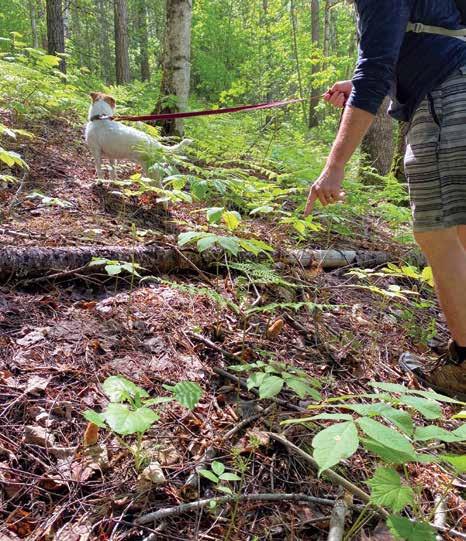 Written by Rob LeClair
Written by Rob LeClair
If you’ve ever enjoyed morels or fiddleheads—as a side dish glistening in butter, in a sauce over risotto or in a rich bisque—you’ll know why these exquisite wild foods are so sought after by chefs and foodies. The decadent, nutty taste of morel mushrooms is a fleeting bliss I look forward to every spring. This is another reason why morels and fiddleheads are so special: they are only grown in the wild, they are elusive and they can only be foraged over several weeks and must be cooked within days.
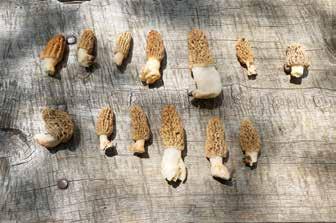
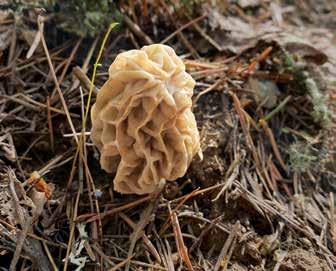

good
FOOD
Nope. That’s a false morel.
No good. This one is too old and dried out to pick.
Spotted! There’s three right here!
What a haul! The Good Life the Magazine of Nature’s Fare Markets | 8
Found one! Beautiful.
We’re very fortunate at Nature’s Fare Markets to have these two ingredients in stores as soon as they’re harvested. Now that you’ve had the chance to learn about wild mushroom foraging from West Coast Wild Foods—and knowing that you might only have a few chances to get it right each spring—I wanted to share my personal tips to find, shop, prep and cook two of my favourite seasonal delights: morel mushrooms and fiddleheads.
In foraging for fiddleheads, I’ve always had the best luck searching close to brooks and streams. They thrive in damp ground and shady areas (in fact, fiddleheads are actually young ostrich ferns). Once you find a patch, harvest carefully and lightly. Don’t over-harvest if you want to return to this spot the following spring. Look for tightly curled heads that are bright green. Take only the young tops that have not begun to unfurl, snapping off very close to the ground.
When buying fiddleheads, choose small, firm fiddleheads that have a bright jade colour; avoid those with yellow or soft patches. Use

Morel Mushroom Risotto
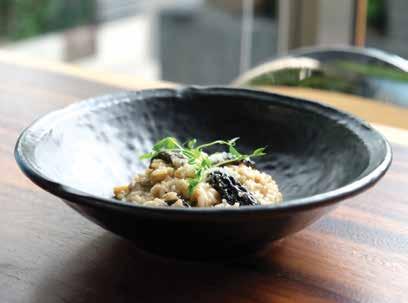
Serves 2
6 cups stock (vegetable, veal, chicken or mushroom)
2 cups dry hard cider (or dry white wine)
1 small onion, minced 2–3 cloves garlic, minced 2 tbsp olive oil
1 tsp thyme (fresh or dried)
1 cup Arborio rice (or Carnaroli if you can get it)
¼ lb morel mushrooms
½ cup Parmesan or pecorino cheese, finely grated
2 tbsp butter
1. Bring stock to a simmer in a medium saucepan.
2. In another medium saucepan, sauté the onion and garlic in olive oil until translucent, about 5 minutes.
3. Add about half the morels along with thyme and sauté for another minute.
4. Add rice to the onion mixture and cook while constantly stirring for about 1–2 minutes until the rice becomes slightly opaque. Season with salt and adjust the heat to keep garlic from browning.
5. Add cider or wine and stir. Allow to the liquid to be absorbed almost completely.
6. Add the hot stock one ladle at a time, stirring frequently, until the stock has been absorbed before adding more, until the rice is slightly al dente. This should take 20–30 minutes of simmering and stirring (or forego a timer and drink a glass of wine instead). The stirring helps to release the starch from the rice and creates a creamy texture. Taste and adjust seasoning if needed.
7. When the rice has absorbed all the liquid and is creamy, remove it from the heat. Add the cheese and stir until it is completely melted.
8. Sauté the remaining morels in butter for 5 minutes. Divide the risotto between plates and top each plate with the sautéed morels. Add more cheese if desired.
9 | May & June 2023
Fiddleheads are the curled, edible shoots of the ostrich fern. Look for them by brooks and streams.
fiddleheads as soon as possible. They can be refrigerated for up to two days, tightly wrapped in plastic. Before cooking, wash them thoroughly, scrape off any fuzzy brown scales and trim the ends. Fiddleheads should not be eaten raw; they must be cooked.

With fiddleheads, I always cook simply. I tend to serve them the way I would asparagus—topped with a vinaigrette; a butter, cream or cheese sauce; or even a soy sauce sprinkled with sesame seeds.


Growing up in Ontario, we hunted morels in old apple orchards, near streams and in the beds of pine and oak trees. Morels come up in late spring, and I’ve known people who check the soil temperature to know when to head out hunting for these rare, honeycomb-shaped fungi.
Morels, as with other wild fungi, can easily be misidentified and cause serious illness, so if you’re just getting started, it’s safest to go foraging with an experienced guide.
If you’re happy to let others do the harvesting and get right to tasting, when buying morels, look for ones that are plump with a moist stem. The darker in colour, the more nutty and earthy the flavour. Take home only those that are moist, and avoid morels that are totally dry, brittle, bruised or softening. Once you get your fresh morels home, soak them in saltwater for 10 minutes so they’re free of any occupants (i.e., insects). Try out my all-time favourite recipe on the previous page: Morel Mushroom Risotto.
“I love to use fiddleheads in brunch dishes; for example blanched and put into a quiche with sundried tomatoes or a frittata with mushrooms (morels!), bacon and chèvre. Another crowd pleaser I’ve done in the past is a take on pissaladière from Provence—a puff pastry tart with caramelized onion, but instead I use buttered leeks, blanched fiddleheads and gruyere. All great for a special brunch.
Rob LeClair is Head Chef and Commissary Operations Manager at Nature’s Fare Markets. He has a deep love for wild-foraged ingredients and recipes.
Falafel Bowl
 Created by Robin at Greens, Eggs and Yams
Created by Robin at Greens, Eggs and Yams
good FOOD
Falafel
Cashew Cream
Turmeric Rice
11 | May & June 2023
Pickled Red Cabbage
This bowl is just what spring ordered. Loaded with fresh veggies, creamy beet hummus and protein-packed falafel, the flavours complement one another beautifully. From the roasted beet and pickled cabbage to the spiced falafel, it’s all fresh, tangy and filled with garlicky goodness.

You have to plan ahead for this! Prepare the hummus, pickled cabbage and falafel ahead of time, and it’s ready to assemble at dinner time.
Serves 4 | makes 22 falafel
Beet Hummus
Time: 1 ½ hours
1 medium beet
1 ¾ cup chickpeas (dried chickpeas soaked the night before or canned)
2 tbsp lemon juice
4 tbsp tahini
pinch sea salt
2 garlic cloves
1. If using dried chickpeas, cover them with water in a large bowl and soak overnight. If using canned chickpeas, start at step 2.
2. Preheat the oven to 400°F. Trim the ends off the beet, but leave the skin on.
3. Wrap the beet in tin foil and place it on a sheet pan. Roast for 60 minutes or until tender.
4. Remove the beet from the oven and set aside to cool completely.
5. Remove the skin and chop it into large pieces.
6. Add the chickpeas and beet to a food processor. Pulse a few times. When just small pieces remain, add the remaining hummus ingredients. Scrape down the sides and continue blending until smooth.
7. This hummus will be on the thicker side. If having trouble blending, add 1 tbsp of tahini.
Pickled Red Cabbage
Time: 20 minutes + a few hours
½ medium red cabbage (about 3 cups)
1 ½ cups apple cider vinegar or white vinegar

½ cup water
3 tsp salt
½ cup sugar
1. Using a mandolin or chef’s knife, thinly slice half of a medium red cabbage to get about 3 cups of shredded cabbage. Add to a large bowl.
2. Add the remainder of the pickled cabbage ingredients to a medium pot. Bring to a boil, and cook until the sugar dissolves. Pour over the cabbage. Let it cool before transferring to a container and refrigerate for a few hours before using.
Continued on next page
Beet Hummus
The Good Life the Magazine of Nature’s Fare Markets | 12
SAVE TIME Canned chickpeas work great for making hummus.
Falafel
Time: 40 minutes + overnight chickpea soak
1 ½ cups dried chickpeas, soaked overnight
½ red onion, roughly chopped
4 garlic cloves
1 cup parsley
1 tsp lemon zest
4 tsp lemon juice
2 ½ tsp cumin
1 ½ tsp coriander
½ tsp black pepper
1 ½ tsp sea salt
2 tbsp avocado oil + 2 tbsp to coat the falafel
1. The night before, soak the dried chickpeas in a large bowl, completely covered with water. (I highly suggest not using canned chickpeas as they will give the falafel a mushy texture.)
2. Preheat the oven to 425°F and line a baking sheet with parchment paper. Drain and rinse the chickpeas. Add all falafel ingredients except the chickpeas to a food processor. Pulse a few times until the ingredients are mixed and chopped. Add the chickpeas and continue pulsing until it is a slightly crumbly but still tacky mixture. Make sure to not over-process into a paste.
3. Use your hands to gently roll into walnut-sized balls (about 22 falafel).
4. Place on the baking sheet, and lightly brush a little more oil on top of each falafel. Bake for 23–25 minutes until golden on top.
Cashew Cream

Time: 35 minutes
¾ cup cashews, soaked
1 tbsp lemon juice
1 tsp apple cider vinegar
pinch salt
½ cup water
1. Soak the cashews in hot water for at least 30 minutes.
2. Drain and rinse the cashews. Add to a small highspeed blender with the remaining cashew cream ingredients. Blend until smooth. Add ¼ cup more water if you have trouble blending.
Turmeric Rice
1 cup cooked brown rice
1 tsp vegan butter or coconut oil
½–¾ tsp turmeric
This versatile dip is one of our faves and can be used in place of the Cashew Cream if you don’t have time to make it from scratch.
1. Prepare rice to make 1 cup according to package instructions.
2. Stir in butter or coconut oil and turmeric. Set aside until ready to assemble.
Salad
1 head of kale, washed, de-stemmed, chopped and massaged with 1 tsp olive oil
1 green onion, finely sliced
½ cucumber, finely chopped
1 cup grape or cherry tomatoes
vegan feta cheese (optional)
Assemble Falafel Bowl
1. Finely chop the cucumber, tomatoes and green onion. Remove the kale leaves from the stem and chop. Transfer the kale to a large bowl and gently massage the leaves with about 1 tsp of olive oil.
2. Add a handful of kale, cucumber and tomatoes to each bowl. Add some of the rice, pickled cabbage, beet hummus and falafel.
3. Top with green onion and drizzle with cashew cream. Optionally, add a little vegan feta cheese.
4. Store any leftovers in the fridge separately. Wait to add the cashew cream until just before eating.
Robin is the creator of the blog Greens, Eggs and Yams. Her passion is creating vegan and gluten-free foods that don’t compromise on taste. She loves being in the kitchen, creating recipes that everybody can enjoy!
IG: @greenseggsandyams

If you are short on time, take some shortcuts! Pick and choose what you want to make from scratch and what you can buy already made.
TAKE A SHORTCUT
13 | May & June 2023
Give your life a surge

Do we know why we age and why some people age faster?
Aging is caused by so many processes; however, DNA and telomere damage as well as mitochondrial dysfunction are the leading causes. Several natural compounds are pivotal to human health and healthy biological aging, notably NAD+.
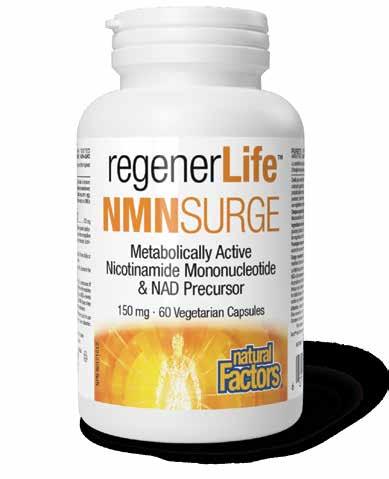
Did you know that by middle age, the body’s NAD+ levels have fallen to half their youthful levels?
Reduced NAD+ levels can result in fatigue and decline in metabolism – leading to weight gain and increased risk of developing
type 2 diabetes, as well as age-related cognitive decline and muscle loss. Numerous studies have demonstrated that boosting NAD+ levels can reverse mitochondrial dysfunction and improve insulin sensitivity. One of the most effective ways to boost NAD+ levels is by supplementing with nicotinamide mononucleotide, also known as NMN. NMN is a precursor to NAD+, and is rapidly absorbed and converted to NAD+. NMN is shown to be superior to that of another NAD+ precursor called nicotinamide riboside (NR).
AVAILABLE EXCLUSIVELY AT NATURAL SUPPLEMENT STORES R e juvenateYourLife!
Gluten-Free Living
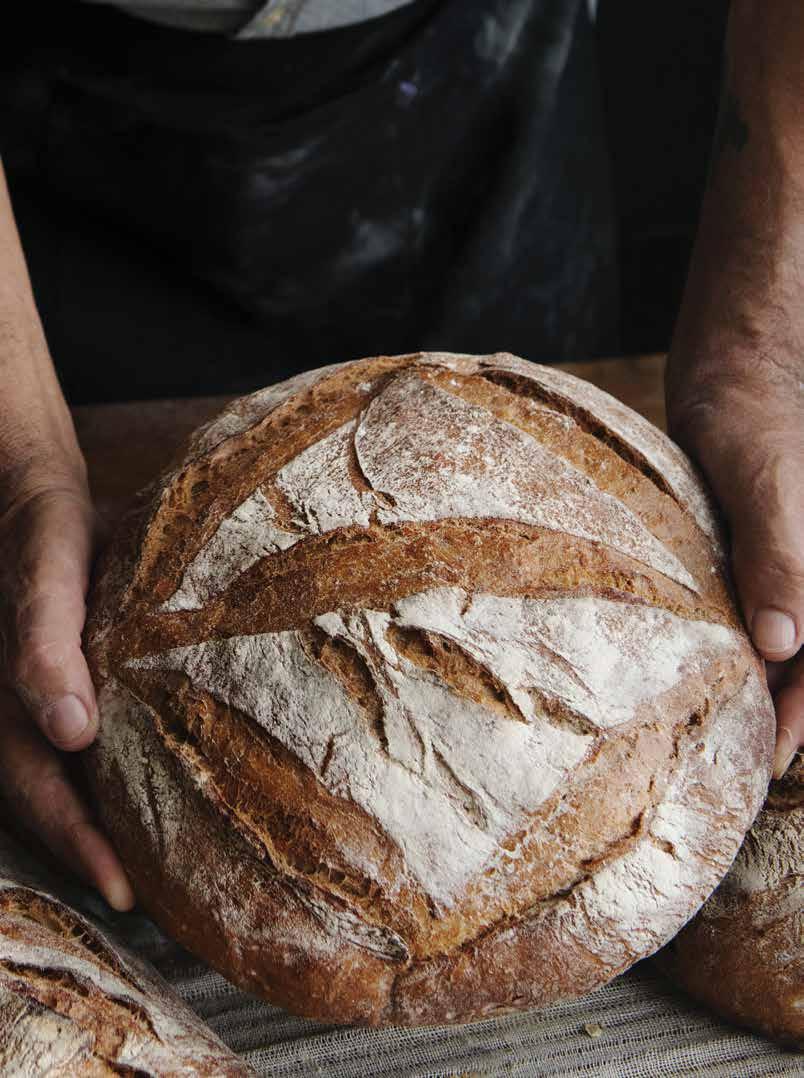 Written by Lisa Kilgour, rhn
Written by Lisa Kilgour, rhn
NUTRITIONIST NOTES good HEALTH 15 | May & June 2023
There’s a good chance you’ve already experimented with a gluten-free diet. Gluten is a protein often blamed for a myriad of health issues, sometimes for good reason. Abdominal pain, bloating, diarrhea, and sometimes even headaches, fatigue, rashes and joint pain have all been attributed to gluten.
The gluten protein is found in wheat, rye, barley, kamut, and spelt, and for some, it spells trouble. The key word is some…not everyone needs to go gluten-free. While I’m a firm believer that food plays a big role in wellness, an unnecessarily restrictive diet can lead to nutritional deficiencies. So, let’s take a dive into gluten and look at when and where a gluten-free diet can be helpful.
One of the reasons that many struggle to digest gluten is because it’s often added to food and the addition of this extra, more processed gluten may be connected to the rise of gluten sensitivity. You might be surprised by just how much gluten is added to your food!
Check the label on a loaf of commercially made bread and you’ll usually find both wheat and added gluten. Gluten helps make your bread softer and fluffy. It’s added to a variety of food, like pasta and cereal, and can pop up in unexpected places like ice cream, medications and beauty products.
Is going gluten-free healthier?
Short answer—no. Over the last 15 years or so, a few health experts have warned about the “dangers” of eating gluten, and I believe that many people are unnecessarily shunning these foods.
While there are a lot of gluten-filled junk foods on the market (just check the cookie and snack-food aisle of a major grocery store), some gluten-containing foods, like sourdough bread, are wildly nutritious and can be a part of your diet. I only recommend going gluten-free when you know you have symptoms related to gluten.
Celiac Disease vs. Non-Celiac Gluten Sensitivity (NCGS)
The symptoms may feel similar, but there’s a huge difference between Celiac Disease and NCGS.
Celiac Disease is an auto-immune condition. The protein in gluten triggers the immune system to attack the lining of the small intestine, which over time can cause nutritional deficiencies and unintentional weight loss. Undiagnosed celiac disease can lead to malnutrition, anemia, joint pain and many other symptoms.
Many people with NCGS will feel the same digestive symptoms but without auto-immune symptoms and intestinal damage. This means if someone with NCGS has a bit of gluten, the repercussions are much less. Eating gluten may trigger inflammation and other immune symptoms, but the immune system doesn’t damage the intestinal lining.
As well, those with NCGS may not be reacting to the protein in gluten but instead may struggle to digest the carbohydrates and fibres in the grains (gluten grains are high in FODMAPs, a sometimes hard-to-digest family of fibre). Or it’s possible they’re reacting to glyphosate (a.k.a. Roundup) residue commonly found on conventionally grown grains. Gluten sensitivity has a wide variety of symptoms and many possible causes.
NCGS might also be circumstantial. It might pop up along with other digestive issues, like leaky gut, and might resolve on its own, especially
Continued on next page
Learn the Lingo Gluten
A general name for a group of proteins found in cereals such as wheat, rye, barley, kamut and spelt.

Celiac Disease
An auto-immune condition. Protein in gluten triggers the immune system to attack the lining of the small intestine, which over time can cause nutritional deficiencies and unintentional weight loss. Undiagnosed celiac disease can lead to malnutrition, anemia, joint pain and many other symptoms.
Non-Celiac Gluten Sensitivity
Same digestive symptoms as celiac disease but without auto-immune symptoms and intestinal damage.
Those with NCGS may not be reacting to the protein in gluten but instead may struggle to digest the carbohydrates and fibres in the grains. Gluten sensitivity has a wide variety of symptoms and many possible causes.
The Good Life the Magazine of Nature’s Fare Markets | 16
Gluten Smart
Small amounts of gluten can affect those with Celiac Disease, so you need to be extra careful to avoid crosscontamination.
Keep kitchen utensils, dishes and other food prep items that are used for gluten-containing foods separate from your utensils. Have a designated glutenfree toaster and butter dish. If possible, keep your house gluten-free. Ask restaurants if they have a glutenfree area in the kitchen and make sure gluten-free pasta is cooked in different water than regular pasta. Always check for warnings on packages. Many gluten-free products may have been processed in a facility where there is gluten. Oats are often contaminated.
Read ingredient labels carefully to check for any traces of gluten. Some artificial colours and seasonings also contain gluten.
Whether you’re embarking on a glutenfree life or are interested in seeing how glutencontaining foods affect your body, Nature’s Fare has made it so much easier for you. Always watch for those handy-dandy green price tags that signify gluten-free food, and you can book an appointment with one of Nature’s Fare’s nutritionists (like me) to help you on your way.
after a gut-healing protocol. Alternatively, Celiac Disease is a life-long condition.
A gluten-free diet is necessary for both Celiac Disease and NCGS, but it’s important if you suspect you have Non-Celiac Gluten Sensitivity to test out gluten occasionally to see if you’re still sensitive.
Testing
If you feel better without gluten and you’re wondering if you might be celiac, the first step is to ask your doctor for a blood test. A celiac blood test will show if you carry the IgA antibody associated with celiac disease. This is the first step; many will follow that up with an intestinal biopsy to confirm the classic celiac damage.
If your blood test is negative but you suspect you may have Non-Celiac Gluten Sensitivity, an elimination diet is a helpful next step. Remove all gluten-containing foods for a minimum of 10 days. After 10 days, spend a day doing a gluten challenge, gobbling up a few servings of gluten, and notice any symptoms that might pop up over the next 5 days. Some immune reactions can take up to 5 days before they show themselves, making this step very important.
If you feel a noticeable difference on a gluten-free diet and those symptoms return during your testing phase, you might benefit from a gluten-free diet. I usually recommend following a gluten-free diet for three months
before doing another gluten challenge. Having an end date for your gluten-free diet can help reduce feelings of deprivation and can make the process much easier.
But, if you test positive for Celiac Disease, a gluten-free diet is important for life. This will allow your intestinal tract to heal and reduce other inflammatory symptoms that gluten triggers in your body.
Gluten-free Made Easy

Eating a gluten-free diet has become easier over the last 10 years. There are amazing gluten-free alternatives for most products, and many restaurants have a gluten-free menu.
Common sources of gluten to watch out for are wheat, rye, barley, spelt, kamut, semolina, couscous, malt and brewer’s yeast.

• Nature’s Fare has made your gluten-free eating easier by marking all gluten-free products with a green price tag. Just scan the aisles and look for that green tag! They’ve done all the hard work for you.

• Substitute oat, buckwheat, quinoa or other gluten-free or alternative grain flours for wheat and other gluten flour in cooking and baking.
• Watch your condiments, as many are surprisingly high in gluten. The biggest culprit is soy sauce—wheat is often the first ingredient! Gluten-free tamari is a great alternative.

Lisa Kilgour, rhn is one of Nature’s Fare Markets’ nutritionists and sought-after speaker and educator who helps people heal from diverse and complex health issues. She has spoken at TEDxKelowna and is the author of Undieting: Freedom from the Bewildering World of Fad Diets. Book your free appointment today at naturesfare.com
Learn more: lisakilgour.com

| CELIAC LIVING |
Talk 1-on-1 with a Nutritionist Ready to take charge of your wellness? Book your FREE 30-minute appointment today. Scan or visit naturesfare.com
17 | May & June 2023
You might be surprised by just how much gluten is added to your food!
Advanced Gut Health

Probiotic Womens Daily
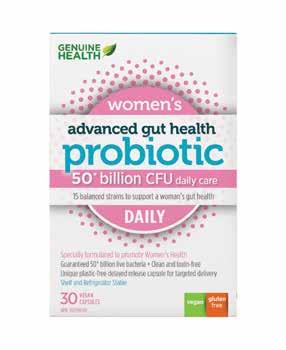
Made uniquely for women by women to support gut health, digestion, skin & immunity all at once.
Fermented Organic Vegan Proteins+

20g of smooth & delicious plant-based protein, fully fermented for no bloat.
Greens+ Extra Energy
Immediate & lasting energy with just 1 scoop of the first & only research-proven superfood formula.

WHAT WE DO MATTERS WHAT WE PUT IN THE BOTTLE MATTERS
OUR PEOPLE MATTER HOW WE TREAT THE PLANET MATTERS
The call for ‘tampon transparency’ got a lot louder in October 2015. At a rally outside the corporate offices of a major US maker of feminine hygiene products, women wearing giant boxes of pads and tampons shouted, “Detox the box!”, “Chemicals don’t belong in my tampons, period!”
Soon after that New York rally— organized by women’s health advocacy group Women’s Voices for Earth (WVE)—a handful of major brands began sharing the ingredients in their feminine hygiene products.
Some of us still remember the scare of toxic shock syndrome (TSS) in the 1970s and 80s, when super absorbent tampon ingredients created a major public health concern, and makers largely moved away from those ingredients. So back
Period Pride
Organic cotton tampons, silicone menstrual cups that last five years, and eco-friendly, leakproof underwear are just the start. It’s a whole new world in the ‘feminine products’ aisle—and Canada has become a centre for both sustainable period products and empowering conversations. To get here, women had to ask a lot of questions about the questionable tampons and pads that spend an awful lot of time in the vagina.
in 2015, and for several years prior, what WVE rally protesters wanted clarity about was chemicals linked to cancer and allergies that they suspected were present in most conventional pads and tampons.
Since companies are not required to disclose all the components that go into their raw ingredients (pads and tampons are classified as ‘medical devices’ and labelling laws don’t require the disclosure of unintentional ingredients), WVE expressed concern about how cotton and rayon were treated, and the traces of chemicals in vague labels like ‘fragrance,’ ‘flex foam’ and ‘adhesives’.
“We believe that women need more information about what these generic terms mean—and what chemicals they include,” a WVE organizer told the CBC.
At that turning point rally in New York, one woman’s sign was a sketch of a uterus that declared it “loves accurate labels”.
Why do women need to know what they’re really putting inside their bodies, month after month, year after year?
Our Chemical Parts
Most women will menstruate for about 40 years, using 16 to 20 tampons every cycle (no, gentlemen, not one tampon for the whole period). That’s a possible 12,000 tampons in a lifetime. Total tampon time spent in your uterus? Six years.
And in all those cycles, what is your vagina exposed to?
Many conventional products use a chlorine-bleaching process that can create toxic by-products, including dioxins. Dioxins are known
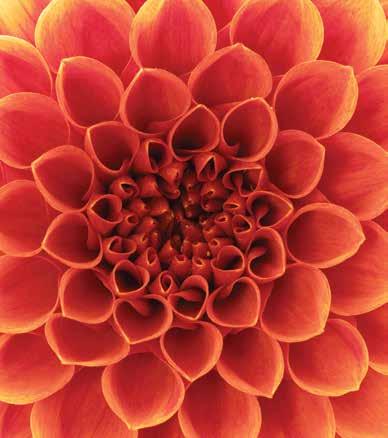
good HEALTH
19 | May & June 2023
carcinogens, they’re hormone disruptors, they’ve been implicated in endometriosis and they bring chemicals to the reproductive and immune systems.
Cotton that has been exposed to pesticides and insecticides also puts us at risk of more exposure to dioxins, as does rayon. Dioxins are good at sticking around, accumulating in fatty tissues. (And if they’re slow to break down in our bodies, they’re sure to do the same in waterways and landfills.)
Lastly, many of the hundreds of chemicals that can fit under the umbrella ‘fragrance’ term are also hormone disruptors, as are parabens.
How much of that exposure is safe?
While feminine hygiene product makers claim their tampons and pads aren’t harmful and that these are only ‘trace amounts’ of chemicals, studies are lacking and advocates say when it comes to our reproductive organs, no amount of chemicals is safe.


Now, with more awareness about the potential impact of what could be inside a tampon or pad, and your body, and with more labelling transparency, women can educate themselves and make choices.
If you’re a menstruator here in Canada, all the better.
Radical Pads and She-pioneers
You might have noticed that Canada’s period products industry is kind of having a moment. After decades of bulky, bleachy non-innovation around the world, a handful of mostly women-led, carbon neutral companies from across the country are offering an almost dazzling array of sustainable, safe and even fashionable choices. What’s more, these brands are turning up the volume on a conversation that’s shifting period talk from one of embarrassment to one of empowerment.
A Plethora of Period Products
Here are just some of the radical options that are safe for your vagina and our landfills, and great for body positivity.
REUSABLE PADS Aisle
Gender-neutral styles of underwear for transgender and non-binary menstruators are a new addition to their line of reusable cloth menstrual pads, underwear and cups.
CUPS
The name says it all. Made from medical grade silicone, the cup sits inside the vagina to collect menstrual blood rather than absorb it. This means that it can be worn for extended periods of time without the risk of toxic shock syndrome. They come in two sizes for those under or over the age of 25 or those who have given birth.


Liberty Cup DivaCup

TAMPONS Natracare


This is the world’s first organic cotton tampon. Started in 1989, the company has led the way in awareness for both women’s health and environmental care. They have a full line of pads and tampons, all with zero chemicals, plastics or toxins.
UNDERWEAR Revol Cares
Revol Cares makes sustainable and obsessively-perfected, PFAS-free, leak-proof underwear. They prioritize safe materials that are sustainably sourced, and make reliable leak-proof undies that are a dream to wear, so you can feel just as good in them as you do about them.

The Good Life the Magazine of Nature’s Fare Markets | 20
Double Dew-ty
Written by Brianne Rempel
PRO TIP
Keep this in the fridge during the hot summer months so you’re always ready to enjoy a nice, cooling spritz!
ROSEWATER & GLYCERIN HYDRATING FACIAL MIST

This is what’s been missing from our skincare routines! Heritage Store’s Rosewater & Glycerin Facial Mist instantly hydrates the skin, and with every use, boosts that all-important barrier function. Think of all those moments after you leave the house when your skin just needs a little refresh: late afternoon, after a flight, after a workout.
Taking time to carefully choose products that you love, that are good for your skin and hair, and that can be used in multiple ways can save you time and money, and cut down on packaging. Plus, it makes for light and easy summer packing!
Fortunately, there are tons of effective and earth-friendly products out there that are brilliant at doing double or even triple duty. Here are just a few multi-use products that we love:
BRONZER


A luxurious facial mist like this can be applied after cleansing for deeper, all-day hydration—and it’s brilliant at setting your makeup in the morning.
Last, if you use a heavier moisture cream at night and it’s the perfect texture in winter but too thick for the warmer months, add a spritz or two of Rosewater & Glycerin to your fingertips to make your cream lighter (and last longer)!
Bronzers give the skin that coveted sun-kissed glow—and natural blends can extend that beachy look beyond your cheeks and forehead. Good bronzers also make fantastic eyeshadows, bringing warmth and depth to your crease. Need a lip colour on the fly? Add a dash of bronzer pigment to your lip balm for a rich neutral shade.

good SELF-CARE
21 | May & June 2023
FACIAL OIL
Facial oils are incredible nourishers, and those that use some of the most beneficial ingredients bring lasting suppleness and radiance. Ellie Bianca’s line of facial oils glide on smoothly and hydrate deeply, giving your skin a bright, healthy canvas for the day.
In your daily routine, for best results, use face oils as a second-last step— just before applying a moisture cream that locks in all those powerhouse antioxidants.
Now, take the remaining oil on your palms and run through your hair to add nutrients and shine.
What else? Face oils have nothing on dry cuticles and hands, which are one of the first places to show signs of aging and sun damage. With a light, sweet fragrance (choose from rose, citrus verbena, frankincense or naked), you can always add a drop of Heritage face oil to your wrists and neck for a subtle and natural perfume.
Worried a face oil will make your skin oily? Premium, natural lines are made with the finest quality oils so they’re super absorbent and dry to a matte finish. They’re even good for oily skin!
EGYPTIAN MAGIC ®

If you’re travelling or decluttering the bathroom cabinets, this is one product worth its place. A go-to moisture product among celebs for decades, Egyptian Magic brings your skin the healing power of honey, pollen, beeswax, bee propolis and royal jelly. This multitasking queen has more than a dozen uses.

Cracked heels and elbows
Eye cream
Face mask
Hair conditioner
Hand and cuticle cream
Lip balm
Moisturizer (warm a small amount in your fingertips and apply)
Tattoo after-care
Treating skin irritations, burns and scars

Vaginal moisturizer and lubricant (topical use)
LIPSTICK
Your favourite lipstick can bring a pop of colour to more than just your lips. Slide your blush brush gently across the side of your lipstick and apply along the top of your cheekbones for a dewy flush. Create a bolder, monochromatic look by sweeping your eyeshadow brush across your lipstick, then gently onto your eyelids in place of an eyeshadow.

BLUSH
Blush is another great makeup multitasker. The Mad Hippie cream blushes are so easy to use with just your fingertips when you’re on the go. Besides adding a lovely shimmer to your cheeks, this natural blush line can be used as an eyeshadow or lipstick.

Brianne Rempel is just as passionate about clean beauty and skin care as she is about self-growth and kindness. As our health and beauty specialist, Brianne helps us select plant-based personal care products that are eco-friendly yet effective, and she trains our team members so you can make the most of your skincare regime. Brianne brings 20 years of retail experience, where she enjoyed the chance to positively impact store culture and perfect the workplace hug.

Bee Cause
Protecting and Enjoying our Precious Pollinators
There’s something magical about happening upon a bee in the garden or in the woods— the way it hover-flies and lands on the petal of a lupine flower, clutches the golden pollen and, with that tiny straw mouth, drinks the nectar. With bee survival in peril, will our children’s children know this joyful sight? As World Bee Day nears on May 20, we reflect on what’s keeping bees from thriving, how organic farming is protecting them, and the sweet, soothing ways you can bring home the power of bees.
It was nearly 20 years ago, in 2006, when US beekeepers began to report that worker bees were disappearing, fleeing their nests, queens and even their own larvae seemingly without explanation.
Soon, word began to spread about the collapse of colonies and what it would mean to the world if this carried on: without our pollinators, we won’t have plants. Without plants, we risk our air, water, food and medicine—you know, the big things.

“Did you hear about the bees?” Neighbours in their gardens, trowels in hand, spoke over fences about the problem. Some American honeybee hives lost 30 to 90 per cent of their colonies. Gone.
What did it? The list of threats against the survival of bees is long, and growing. Among the most pressing are climate change, loss of habitat, invasive plants, low genetic diversity, diseases spread by industrial bees, and pesticides. In the year of the vanishing bees, studies now suggest that last threat, pesticides—specifically, the agrochemical neonicotinoids—was likely the major factor that caused bees to flee. Turns out neonicotinoids, a class of insecticides, grow plants with toxic pollen.
good
TO THE EARTH
BEE ORGANIC
23 | May & June 2023
Sproule & Daughters Farm is one of our local organic cherry growers. Organic farms like this use practices that are good for bees.
Hive-powered Canadian products
Experience the sweetness and wonder of bees and contribute to these makers’ efforts to help protect these precious pollinators.
BEEKEEPER’S NATURALS
Did you know bees themselves use propolis to protect the hive? It was this stand-up ingredient that finally gave Carly Stein relief for her own tonsilitis, and so began a quest to bring others effective bee medicine. Today, bestsellers from Beekeeper’s Naturals include Propolis Throat Spray, raw honey enhanced with royal jelly and pollen, and a pollen multivitamin.
ELIAS HONEY
Everything is better with honey, but not just any honey. Elias Honey is 100% pure, apiary-fresh BC honey with incredible flavour.

Founder Dietrich Elias savoured every spoon of a pot of Canadian creamed honey sent to him in the 1940s before he left Western Europe for Canada. Today, Elias brings honeylovers everything from classic to creamed and gourmet blossom varieties to coldpressed.
Today, there’s so much more awareness about the importance of protecting our pollinators and our health. The European Union has banned the use of neonicotinoids. The Bee Cause project is leading a movement to inspire a generation of environmental stewards. Here in British Columbia, groups are lobbying for more land biodiversity and protected “pollinator pastures”.
What we also have going for us are the organic farms that are helping to keep bees alive.
The Fruits of the Organic Farmer’s Labour
If it were easy, more farms would do it. When organic farmers wake up early to water and weed and harvest in the field, they do it
EGYPTIAN MAGIC ®
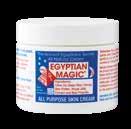
Beeswax, honey, bee pollen, royal jelly and bee propolis make up five of the six ingredients in the all-natural Egyptian Magic cream. This multi-tasking wonder balm has been lauded by celebrities since the 1990s for its ability to soothe scars, nourish dry skin, tame frizz and hydrate parched lips.


SATYA ECZEMA RELIEF
Those who know the itchiness and redness of eczema know that finding lasting comfort and confidence isn’t easy. Satya’s Eczema Easy Glide Stick uses beeswax, along with other botanical ingredients, to naturally soothe even the most sensitive skin. Plus, it’s refillable!
HONEY CANDLES
Handcrafted in BC with love and 100% pure Canadian beeswax, Honey Candles bring any room a warm glow and that subtle beeswax aroma. Choose from pillars, votives, candlesticks and charming ornamental designs inspired by nature.

without pesticides, herbicides and some of the government subsidies afforded conventional farmers. Organic farmers are alone against the elements—heat waves, droughts and pests—as they passionately raise those juicy peaches or spears of asparagus.
But they do it anyway, because they believe in food security, biodiversity and feeding their communities fruits and vegetables that are as healthy and fresh as they are delicious. That’s good news for us, our pollinators and the earth.
Organic practices support bee health in two critical ways: One, it means less exposure to toxic chemicals used in industrial agriculture, especially those neonicotinoid
insecticides. Two, because organic producers manage their farms in ways that maintain and improve natural resources, often becoming home to a diverse landscape of flowering plants, more native habitat is protected and biodiversity is preserved. The more plant diversity and sources of sufficient pollen and nectar, the better bees are at contributing to a thriving hive.
The Fruits of Bees
We take care of the bees, and the bees take care of us. Bees bring us wax and honey, one of nature’s sweetest ingredients. While honey is a tasty addition to toast and tea, it’s also highly beneficial—soothing coughs, healing burns, providing immune-boosting nutrients and more.
The Good Life the Magazine of Nature’s Fare Markets | 24
New look. Same Zevia.

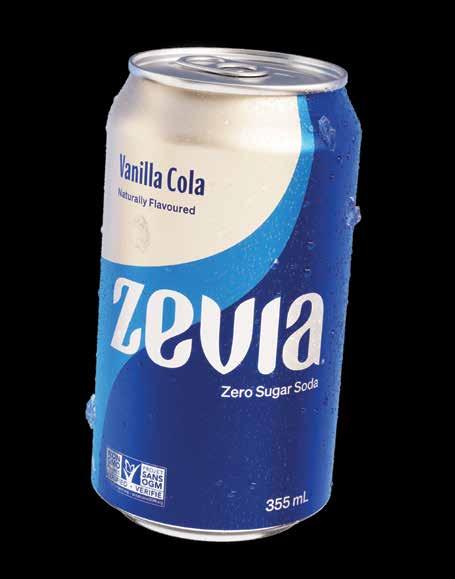

for new flavors, Vanilla Cola and Cherry Cola, available now in Nature’s Fare stores.
look for all new Zevia packaging in stores this summer! VEGAN VÉGÉTALIEN www.zevia.ca In stores now!
Look
And
Grow Your Own Microgreens

UPCYCLED PACKAGING CRAFT
Created by Jen Kossowan
Spring is here and the increased daylight means it’s the perfect time of year to start an indoor container garden of fresh microgreens to use in the kitchen. You can use traditional planting containers, of course, but should you not have any on hand, bistro containers are perfect for growing microgreens! Plus, why not get some extra use out of them before sending them to the compost, right? This is a simple, satisfying planting project that comes together quickly and is great for getting kids involved in too!
SUPPLIES
soil seeds water

good SELF-CARE
take-away containers pushpins The Good Life the Magazine of Nature’s Fare Markets | 26
1. PREP CONTAINER
Rinse or wash your container with lukewarm water and dry. Do not use hot water as compostable containers will begin to break down with too much heat. Use a pushpin to poke a generous number of drainage holes in the bottom of the container, wiggling the pushpin slightly in each hole to expand the size of the hole a bit to ensure good flow of water.
2. FILL
Fill the container with a couple inches of soil and gently pat down evenly. Place the container onto a plant saucer or a shallow pan to catch excess water from watering.


3. PLANT SEEDS
Spread a generous layer of seeds over the surface of the soil. Lightly press the seeds into the soil using the palm of your hand. Choose either regular seeds or speciality microgreens seeds—both will work well.

4. WATER
Generously water the seeds using either a spray bottle or by setting the containers in a shallow dish of water for a minute or two then remove and allow excess water to drain.

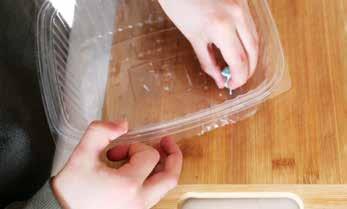
5. GIVE SUNLIGHT
Find a warm, sunny spot for your container garden. The more sun, the better!
6. MIST
Keep your soil moist—but not wet—with regular misting. Before long, seedlings will begin to appear! Keep misting daily as they grow.
7. PICK
When the microgreens are a decent size, they’re ready to harvest! Simply pull them from the soil—roots and all—or cut each stem above the soil line with scissors. Rinse any soil off and enjoy!
| FILL YOUR CUP | Mini Greenhouse
Here’s another fun way to repurpose take-away containers! Two take-away cups, stacked open ends together, make a great mini greenhouse! Poke holes in the bottom cup for drainage and use a piece of tape to hold the cups together if needed. A mini greenhouse like this is best for growing fresh herbs as it has more space for root development. Keep the top cup on until sprouts appear, then feel free to remove it to allow room for growth.
Wash and poke drainage holes into your container.
Plant seeds.
Fill with soil.
27 | May & June 2023
Give plenty of water and light.
Mint Chocolate Chip Super Smoothie

Enjoy your freshly-grown microgreens and herbs with this creamy, nutritious smoothie.
1 cup tightly packed microgreens (kale or spinach are excellent)
⅓ cup tightly packed fresh mint leaves
3 medium bananas, frozen
2 medjool dates, pitted
1 cup plant-based milk
⅓ cup mini dark chocolate chips or cacao nibs
1 tsp pure vanilla
½ tsp mint extract (optional)
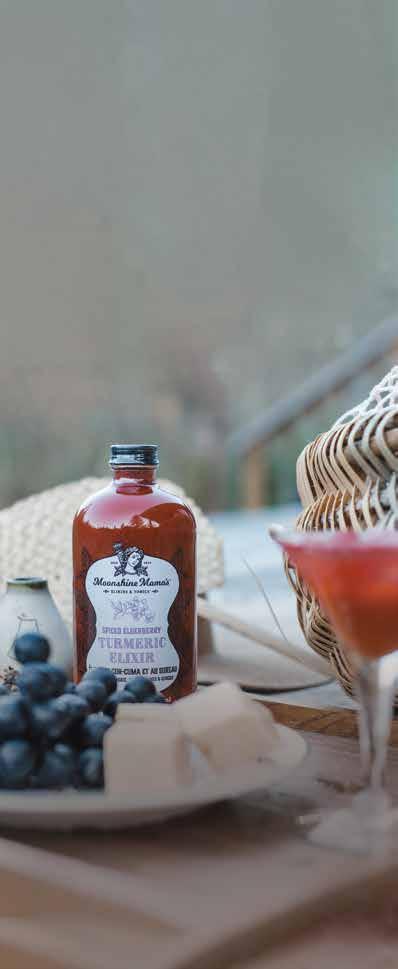
1. Place all of the ingredients except the chocolate chips or cacao nibs into a high-powered blender and blend until smooth. If the smoothie is too thick, add a little extra plant-based milk to thin it out then blend more until incorporated.
2. Add the chocolate chips or cacao nibs and blend for just a couple of seconds more. You want the chocolate to be slightly broken up, but still chunky.
3. Pour the smoothie into two cups and top with coconut cream, extra chocolate chips or cacao nibs and a fresh sprig of mint, if desired. Serve with a straw and spoon and enjoy!
Jen Kossowan is a kindergarten and grade one teacher and mama of two gorgeous kiddos. She’s passionate about play, loves a good DIY project, and can most often be found in her kitchen whipping up recipes that taste delicious while meeting her crunchy mama criteria. She started Mama.Papa.Bubba. on a whim in 2010 while living in the Middle East and has been sharing her recipes and activities there ever since.
Learn more: mamapapabubba.com | IG: @mamapapabubba

The Good Life the Magazine of Nature’s Fare Markets | 28
Pick Local Flowers
Just try to hold a bouquet of fresh-cut flowers in your hand and not feel a little giddy. You inhale that subtle, sweet, rising fragrance. You study the revelry of colours—yellows, violets, pinks. You touch the soft, velvety petals. Yes, this is joy. Fresh-cut flowers bring the beauty and wonder of nature into our kitchens and living rooms; they are messengers of sentiments to those we love, and they evoke some of our strongest memories. With rows and rows of untouched goldenrods, black-eyed Susans, lupines and marigolds— some of the flowers our pollinators love best—organic flower farms also play an increasingly critical role in the survival of bees. At Nature’s Fare Markets, local, organic farming is very important to us, and that extends from fruits and veg to blooms. We’re fortunate in BC to be able to bring customers exceptionally beautiful fresh-cut bouquets. So, we invite you to meet the small local floral farms we’ve developed relationships with so you can support local growers (and those precious bees!) this spring.
DIRTY
BEE FLOWER FARM West Kelowna
Make the everyday or a special day even brighter with fresh-cut garden bouquets of cosmos, dahlias and the most lovely foliage grown, harvested and designed by the selfdeclared “fun haver” Arlene Schuppener. You can also visit her u-pick flower farm and watch the bees enjoying nectar parties.
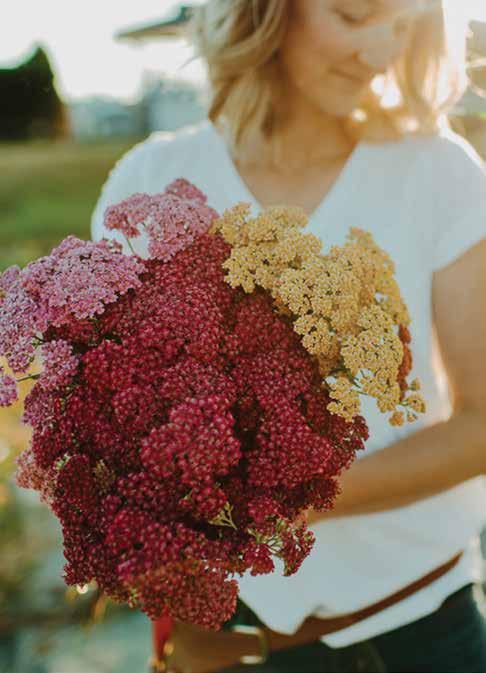
JODIE RAE’S FLORAL BOUQUETS
Kelowna
Hand-tied or gathered in a mason jar, Jodie Rae’s bouquets bring us the simple beauty of the season’s brightest—from sunflowers and mums to tulips, tiger lilies and dahlias. These farm flower blooms are fresh, organic and utterly delightful.
BACKCOUNTRY BLOOMS Lumby
Located on the edge of the Monashee
Mountains in Lumby, Backcountry Farms delivers their seasonal bouquets to Nature’s Fare Markets so you can enjoy the aroma and ambience of arrangements jumping with magnificent snapdragons, bluebells, dianthus, tulips and more.
HAWTHORN FARM STUDIO Vernon Florist-artist Amy Kermociev and her husband, Caleb, cultivate nearly 40,000 flowers under the Okanagan sun every spring. Fresh cut bouquets might be dressed in anything from sunflowers, peonies and tulips to daffodils, sweet peas and foxgloves. This small-scale flower-farm/art studio also brings you hand-crafted pottery stoneware and nature-inspired art cards.
good TO THE EARTH
Hawthorn Farm Studio
Vernon Kelowna
West Kelowna 29 | May & June 2023
Lumby
La Tortilla Factory
Cassava Tortillas
Elevate your day with Organika Spirulina, GT’s Sacred Life Kombucha and vegan protein, blended with banana, mango and coconut milk. Available in the Bistro until May 31.

Taste Buddies Dressings




Made by foodies for foodies from clean simple ingredients, these dips, dressings and sauces are a flavour experience. Plantbased, gluten-free and sugar-free, they are perfect for the whole family.
Made
in BC
Spread’em On the Go Snacks
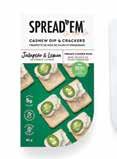
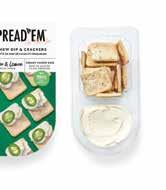
Just the right amount of the cashew dips you love are paired with delicious gluten-free crackers, making them the perfect snack for on the go. Available in Chives & Garlic, Spinach & Artichoke and Jalapeño & Lemon.


Konscious Plant-based Seafood
At Konscious, all the flavours of traditional sushi and seafood are rolled into plant-based goodness. The chefs at Konscious make 100% plant-based frozen options that allow for quick and convenient healthy eating on the go. Find their Gomae, Rolls and Poke Bowls in the freezer section.
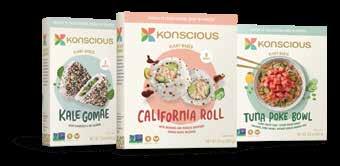
a Bag
PROTECT OUR LAND
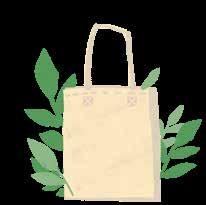
GOOD STUFF IN-STORE New
When you bring your own bag, you’re helping to protect and restore habitat right here in BC. So far, our program has raised $124,095.34 Save
OUR BISTRO
Emerald Bliss Smoothie
PROUDLY SUPPORTING
Gone are the gluten-free days of cardboard-y textures and strange flavours. These tender, gluten-free wraps taste just like their silky flour tortilla counterparts. Made with cassava flour and free of any wheat, soy and dairy, these wraps are where it’s at when it comes to being gluten-free. And they’re back! Fans will be happy to know they’re available again in Canada.
Made in BC Made in BC

Kelowna 1876 Cooper Road 250.762.8636 West Kelowna 3480 Carrington Road 250.707.3935 Langley 19880 Langley Bypass 778.278.1300 White Rock 15180 North Bluff Road 778.291.1321 Kamloops 1350 Summit Drive 250.314.9560 Penticton 1770 Main Street 250.493.2855 Vernon 3400 30th Avenue 250.260.1117 Open seven days a week. naturesfare.com Let’s keep in touch! Follow us on Instagram, Facebook and YouTube. If it’s good for you, we’ve got it.
































 Written by Rob LeClair
Written by Rob LeClair








 Created by Robin at Greens, Eggs and Yams
Created by Robin at Greens, Eggs and Yams






 Written by Lisa Kilgour, rhn
Written by Lisa Kilgour, rhn






































































